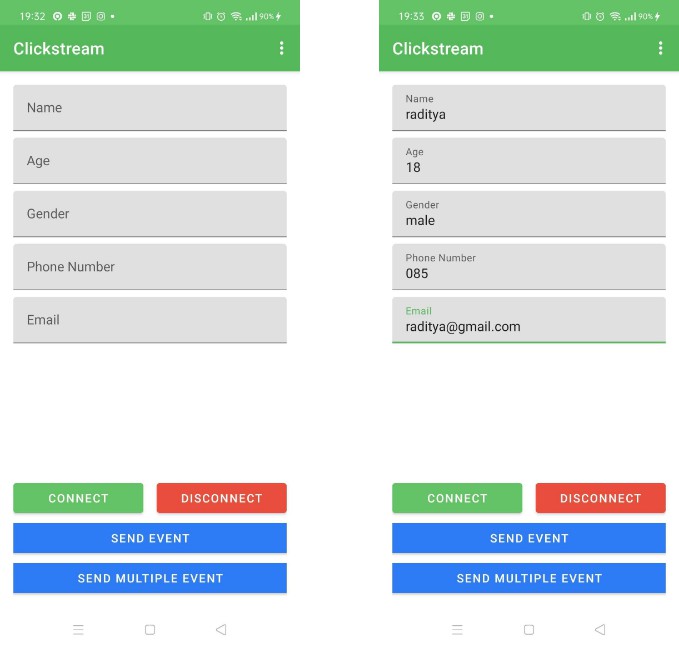A Modern, Fast, and Lightweight Android Ingestion Library
Clickstream is an event agnostic, real-time data ingestion platform. Clickstream allows apps to maintain a long-running connection to send data in real-time.
The word “Clickstream” is a trail of digital breadcrumbs left by users as they click their way through a website or mobile app. It is loaded with valuable customer information for businesses and its analysis and usage has emerged as a powerful data source.
To know more about Clickstream, you can read our Medium post
Clickstream provide end to end solution for ingestion platform purposes. For setup the infrastructure please check raccoon
Architecture
Mobile Library Architecture
Key features
- Simple and lightweight
- Remotely Configurable
- Support for real-time data
- Multiple QoS support (QoS0 and QoS1)
- Typesafe and reusable schemas
- Efficient payloads
- In-built data aggregation
Getting Started with Clickstream
- Add the maven repository URL to the root
build.gradleof your project.
buildscript {
repositories {
mavenCentral()
}
}
- Add the following dependencies to your module
build.gradle
dependencies {
val version = "x.y.z"
implementation 'com.gojek.android:clickstream:[latest_version]'
}
- Add the following rule in proguard.pro or dexguard-project.txt
-keep class * extends com.google.protobuf.GeneratedMessageLite { *; }
Once you’ve added the dependencies and synchronized your Gradle project, the next step is to initialize Clickstream.
Initialization
Initialization of the Clickstream can be done on the background thread or main-thread, Invocation should be done on the Application class. So that the initialization happens only once.
To create a Clickstream instance you can do the following setup:
class App : Application() {
override fun onCreate() {
initClickStream()
}
private fun initClickStream() {
ClickStream.initialize(
configuration = CSConfiguration.Builder(
context = context,
info = CSInfo(
appInfo = appInfo,
locationInfo = locationInfo,
deviceInfo = csDeviceInfo,
customerInfo = customerInfo,
sessionInfo = sessionInfo
),
config = getBuildConfig(config)
).apply {
setLogLevel(DEBUG)
setCSSocketConnectionListener(connectionListener())
}.build())
}
/**
* @see [CSConnectionEvent] for more detail explanation
*/
private fun onConnectionListener(): CSSocketConnectionListener {
return object : CSSocketConnectionListener {
override fun onEventChanged(event: CSConnectionEvent) {
is OnConnectionConnecting -> {}
is OnConnectionConnected -> {}
is OnMessageReceived -> {}
is OnConnectionClosing -> {}
is OnConnectionClosed -> {}
is OnConnectionFailed -> {}
}
}
}
}
Configuration
CSEventSchedulerConfig
Holds the configurations for Clickstream. These constraints allow for fine-grained control over the library behaviour like duration between retries, flush events when app goes in background, etc.
| Description | Variable | Type | Default value |
|---|---|---|---|
| Number of events to combine in a single request | eventsPerBatch | Int | 20 |
| Delay between two requests (in millis) | batchPeriod | Long | 10000 |
| Flag for enabling forced flushing of events | flushOnBackground | Boolean | false |
| Wait time after which socket gets disconnected | connectionTerminationTimerWaitTimeInMillis | Long | 5000 |
| Flag for enabling flushing of events by background task | backgroundTaskEnabled | Boolean | false |
| Initial delay for background task (in hour) | workRequestDelayInHr | Long | 1 |
CSNetworkConfig
Holds the configuration for network related. e.g configure timeouts for network channel.
| Description | Variable | Type | Default value |
|---|---|---|---|
| Endpoint for web socket server | endPoint | String | No Default Value |
| Connect timeout to be used by okhttp (in seconds) | connectTimeout | Long | 10 |
| Read timeout to be used by okhttp (in seconds) | readTimeout | Long | 10 |
| Write timeout to be used by okhttp (in seconds) | writeTimeout | Long | 10 |
| Interval between pings initiated by client (in seconds) | pingInterval | Long | 1 |
| Initial retry duration to be used for retry backoff strategy (in milliseconds) | initialRetryDurationInMs | Long | 1000 |
| Maximum retry duration for retry backoff strategy (in milliseconds) | maxConnectionRetryDurationInMs | Long | 6000 |
| Maximum retries per batch request | maxRetriesPerBatch | Long | 20 |
| Maximum timeout for a request to receive Ack (in milliseconds) | maxRequestAckTimeout | Long | 10000 |
| OkHttpClient instance that passed from client | okHttpClient | OkHttpClient | No Default Value |
CSEventClassification
Holds the class name to be classify into InstantEvent (QoS) or RealtimeEvent (QoS1).
| Description | Variable | Type | Default value |
|---|---|---|---|
| Holds all the eventTypes | eventTypes | EventClassifier | [EventClassifier(identifier: “realTime”, eventNames: []), EventClassifier(identifier: “instant”, eventNames: [])] |
Cleanup
Destroy instance of Clickstream, for example can be called when user logs out of the app.
ClickStream.release()
Push an Event
Using Explicit Builder
As Clickstream use a proto definition on the client-side, you can build a MessageLite and send it directly through ClickstreamSDK.
For instance, you’ve defined a proto definition called Rating.java which has the following properties
rating: Float
reason: String
Thus we can build the rating object just by using a Builder Pattern.
val event = Rating.newBuilder()
.setRating(4.5)
.setReason("nice!")
.build()
// wrap event in CSEvent
val csEvent = CSEvent(
guid = UUID.randomUUID().toString(),
timestamp = Timestamp.getDefaultInstance(),
message = event
)
// track the event
ClickStream.getInstance().trackEvent(csEvent)
Congratulations! You’re done!.
Running Sample App
In order to running the sample app, please follow this instruction
- git clone git@github.com:gojekfarm/clickstream-android.git
- cd clickstream-android
./gradlew :app:installDebugor via play button in the Android Studio
| Figure 1 | Figure 2 |
|---|---|
 |
 |
License
Copyright 2022 GOJEK
Licensed under the Apache License, Version 2.0 (the "License");
you may not use this file except in compliance with the License.
You may obtain a copy of the License at
http://www.apache.org/licenses/LICENSE-2.0
Unless required by applicable law or agreed to in writing, software
distributed under the License is distributed on an "AS IS" BASIS,
WITHOUT WARRANTIES OR CONDITIONS OF ANY KIND, either express or implied.
See the License for the specific language governing permissions and
limitations under the License.




